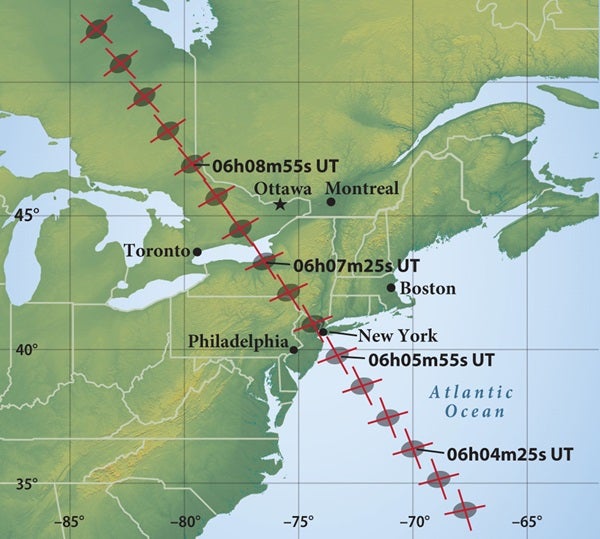In astro-speak, an “occultation” is the passage of one celestial body in front of another, temporarily hiding it from view. A total solar eclipse, when the Moon occults the Sun, is the most spectacular example. The Moon is a veritable occulting machine, its half-degree-wide disk frequently eclipsing bright stars and, on rarer occasions, planets.
Because planets’ disks appear much smaller than the Moon’s, the occultation of a star by a planet is much less common. Two of the three more notable in recent times were the Mars occultation of Epsilon (ε) Geminorum on April 7, 1976, and the July 3, 1989, Saturn occultation of 28 Sagittarii. But the biggie was Uranus’ occultation of the star SAO 156687 on March 10, 1977, which led to the serendipitous discovery of that planet’s rings.
Asteroids also occult stars. Their disks may be minuscule compared to those of the Moon and planets, but their sheer numbers guarantee frequent stellar encounters. In fact, you can anticipate one or two each month from your location, though most involve faint stars and require telescopic aid to see.
Two websites, Steve Preston’s World Wide Prediction Site (http://asteroidoccultations.com) and Derek Breit’s Regional Asteroid Path Maps for the United States (www.poyntsource.com/New/index.htm), list and provide data on pending asteroid occultations of stars brighter than magnitude 12.5 (with a few omissions for extremely faint asteroids). Between the two, you’ll get information on date and time, asteroid and star magnitudes, area of visibility (a sweeping path whose width approximates the asteroid’s diameter), and the magnitude drop and duration in seconds. A map of the occultation ground track and a sky chart showing the location of the star and occulting asteroid round out the information.
Again, nearly all asteroid/star occultations require telescopic aid, as the occulted star is usually too faint to view with the unaided eye. This month, however, there’s a notable exception. During the early morning hours of March 20, a rare occultation of a 1st-magnitude star by an asteroid occurs when 163 Erigone (the number means Erigone was the 163rd asteroid in order of discovery) occults Regulus (Alpha [α] Leonis). Observers along a 67-mile-wide (108 kilometers) track stretching northwestward from the North Atlantic, across New York and eastern Ontario, and on to the Arctic will have a ringside seat to this event.
On the date of the occultation, Erigone will be a magnitude 12.4 speck. You’ll need a 6- to 8-inch telescope if you wish to monitor the asteroid approaching Regulus. Once Erigone becomes lost in the glare of its brilliant target, it’s time to abandon telescope and gaze skyward. At the predicted moment (shortly after 2:06 a.m. EDT for landfall somewhere on Long Island), Regulus will suddenly blink out, offering the eerie sight of the constellation Leo minus its 1st-magnitude star. Regulus will remain invisible for up to 14 seconds before suddenly reappearing.
If you plan to travel to view the Erigone/Regulus occultation, be aware that scientists don’t precisely know the orbits of all asteroids, so the predicted path and times will require frequent revisions. Be sure to consult Preston’s and Breit’s sites for updates, especially as the target date nears. Also be forewarned that March weather in this part of North America is often beset by cloudy skies. (I know from sad experience. I live here!)
If a trek to view this spectacle is out of the question, wait a decade. The next asteroid occultation of a 1st-magnitude star will happen December 12, 2023, when 319 Leona crosses paths with Betelgeuse (Alpha Orionis). The ground track sweeps westward from Turkey, across the Mediterranean that touches southern Greece, Italy, and Spain, and then onward across the Atlantic to Cuba.
Still, the much more common occultations of faint stars are worthwhile events. In recent decades, professional and amateur astronomers have been turning their attention to asteroid/star occultations. The events supply precise information that lead to a more accurate determination of the sizes and orbital positions of asteroids.
If you want to see an asteroid “take out” a star from your backyard, whether in a serious attempt to glean data or to simply be a spectator, let Preston and Breit be your guides. Beyond those, for a complete guide to occultations, from lunar to asteroidal, refer to David Dunham’s International Occultation Timing Association (IOTA) site at www.lunar-occultations.com/iota/iotandx.htm.
Questions, comments, or suggestions? Email me at gchaple@hotmail.com. Next month: a total lunar eclipse. Clear skies!










